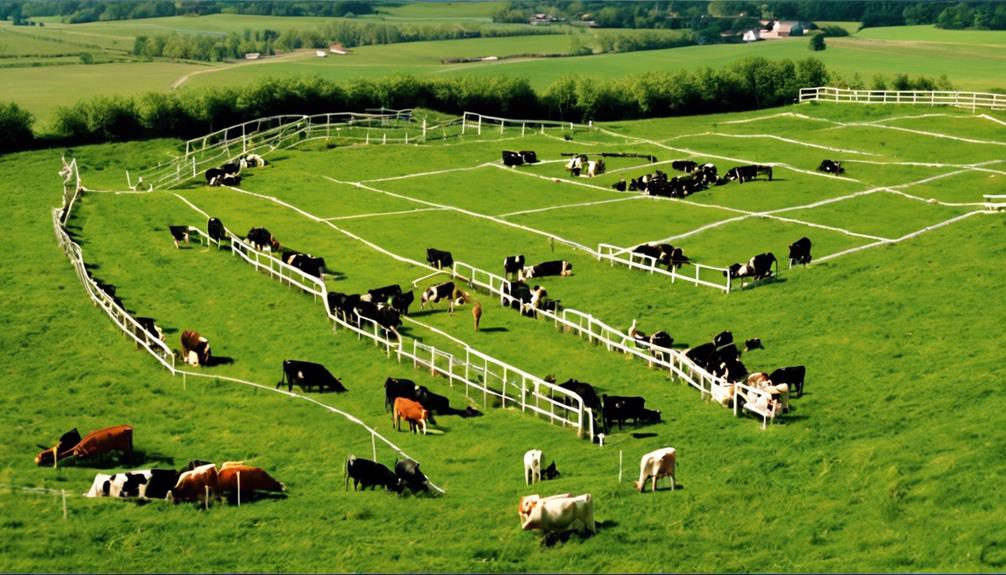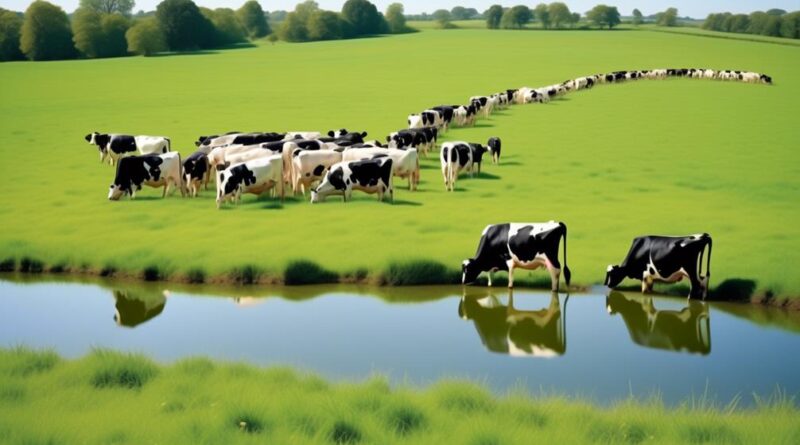Why Is Efficient Pasture Use Important for Dairy Cows?
So, you think cows don't care much about where they graze, right?
Well, think again. Efficient pasture use is crucial for the well-being and productivity of dairy cows.
But why does it matter so much?
Well, let's just say that it's not only about the cows; there are a few other factors at play here that you might find quite interesting.
Benefits of Efficient Pasture Utilization
Maximizing the efficient use of pasture for dairy cows can significantly improve milk production and overall herd health. When cows have access to high-quality pasture, they tend to have improved health, leading to higher profitability for dairy farmers. By allowing cows to graze on nutrient-rich grass, they receive essential vitamins and minerals that contribute to their overall well-being. This results in a reduction of veterinary costs and a decrease in the need for additional supplements, ultimately leading to higher profitability for dairy farmers.
Furthermore, efficient pasture utilization also has a direct impact on milk production. Cows that have ample access to pasture are often healthier and less stressed, leading to an increase in milk production. Additionally, the nutritional value of the pasture can enhance the quality of the milk produced. This, in turn, can lead to higher profits for dairy farmers due to the production of premium-grade milk that commands a higher price in the market.
Grazing Management Techniques
To optimize the benefits of efficient pasture utilization for dairy cows, implementing effective grazing management techniques is essential for maximizing the health and productivity of your herd. Grazing optimization involves strategically managing the movement of your cows to ensure they've access to high-quality forage while preventing overgrazing.
One key technique for grazing management is rotational grazing, where your pasture is divided into smaller paddocks, and cows are moved between these paddocks at regular intervals. This allows forage to recover in each paddock, ensuring a constant supply of nutritious grass for your cows.
Another important aspect of grazing management is forage selection. By choosing the right combination of grasses, legumes, and other forage plants, you can provide a well-balanced diet for your cows while also promoting healthy pasture growth. Forage selection should take into account factors such as nutritional content, palatability, and seasonal availability. It's important to monitor the condition of your pastures and adjust your forage selection and grazing practices accordingly.
Effective grazing management techniques not only optimize the use of your pasture but also contribute to the overall well-being of your dairy cows. By ensuring a steady supply of high-quality forage and promoting healthy pasture growth, you can support the health and productivity of your herd.
Impact on Milk Production
Improving pasture use for dairy cows has a direct impact on their milk production, leading to higher yields and better quality milk. Grazing behavior plays a crucial role in milk production. When cows have access to well-managed pastures, they exhibit natural grazing behavior, which includes increased rumination and improved digestion. This, in turn, leads to better nutrient absorption and overall cow health, resulting in higher milk production.
Additionally, the forage quality of pasture directly influences milk production. High-quality forage provides essential nutrients, such as protein and energy, contributing to increased milk yield and better milk composition. Proper pasture management ensures that cows have access to a diverse range of forage types, promoting balanced nutrition and ultimately enhancing milk production.
Nutritional Advantages for Cows
By diversifying the types of forage available, you can ensure that dairy cows receive a well-rounded diet, leading to improved overall nutrition and health. This has several health benefits, as it enhances forage quality and ensures that the cows receive a wider spectrum of essential nutrients. Here are five key nutritional advantages for dairy cows:
- Improved Digestive Efficiency: Offering a variety of forage types encourages cows to consume a more diverse range of nutrients, which can lead to better digestive efficiency. This, in turn, can reduce the risk of digestive issues and optimize nutrient absorption.
- Enhanced Nutrient Intake: A diverse forage diet provides dairy cows with a broader array of essential nutrients, including vitamins, minerals, and proteins. This can lead to improved overall health and productivity, as the cows receive a more balanced and complete diet.
- Optimized Milk Production: By providing a well-rounded diet, dairy cows can maintain optimal milk production levels. A balanced intake of nutrients supports the cow's energy levels, which can positively impact milk yield and quality.
- Reduced Risk of Nutrient Deficiencies: Diversifying forage types helps to mitigate the risk of nutrient deficiencies. This can contribute to better immune function, reproductive performance, and overall longevity in dairy cows.
- Healthy Weight Management: A varied forage diet can support healthy weight management in dairy cows, ensuring that they maintain an ideal body condition, which is crucial for their overall health and well-being.
Environmental Sustainability
Diversifying the types of forage available not only benefits the nutritional health of dairy cows but also plays a crucial role in promoting environmental sustainability within the dairy farming system. Efficient pasture use contributes to soil health and carbon sequestration. When different forage types are integrated, they can enhance soil structure and fertility. This, in turn, supports the growth of diverse plant species, promoting biodiversity and habitat preservation.
By diversifying forage, you can support the sequestration of carbon in the soil. This helps mitigate climate change by reducing the amount of carbon dioxide in the atmosphere. Additionally, diverse forage types can enhance soil microbial activity, improving nutrient cycling and overall soil health. This not only benefits the pasture, but also the surrounding environment, as healthy soil is better able to retain water and resist erosion.
Moreover, the integration of different forage types creates a more complex and varied habitat for wildlife. It provides shelter, food sources, and nesting areas for various species, contributing to the preservation of local ecosystems. This not only supports the biodiversity of the area but also provides ecological balance within the dairy farming system.
Pasture Rotation Strategies
To maximize the productivity and health of your dairy cows, implementing effective pasture rotation strategies is essential. By rotating your cows through different pastures, you can ensure they have access to fresh, high-quality forage while also promoting soil health.
Here are some key pasture rotation strategies to consider:
- Grazing Schedule: Develop a grazing schedule that allows your cows to move regularly between pastures. This helps prevent overgrazing in any one area and gives the vegetation time to recover.
- Rest Periods: Implement rest periods for each pasture to allow the grass to regrow and replenish its nutrients. This promotes healthier and more abundant forage for your cows.
- Diverse Forage: Rotate your cows onto pastures with diverse forage species. This not only provides a balanced diet for your cows but also benefits soil health by preventing the depletion of specific nutrients.
- Monitoring: Regularly monitor pasture conditions to assess forage availability and soil health. This allows you to make informed decisions about when to rotate your cows to a new pasture.
- Soil Health: Consider soil health when planning your rotation. Rotating your cows can help distribute manure evenly, promoting soil fertility and reducing the risk of nutrient imbalances.
Economic Implications for Farmers

Maximizing the economic benefits of pasture rotation for dairy cows requires careful financial planning and consideration of long-term investment returns. As a farmer, maximizing profit from pasture use involves implementing cost-saving strategies while maintaining high-quality forage for your dairy cows.
One key economic implication is the reduction of feed costs through pasture rotation. By strategically rotating your cows through different pastures, you can ensure that they've access to fresh, nutrient-rich forage, reducing the need for costly supplemental feed. This not only cuts down on immediate expenses but also contributes to the overall health and productivity of your herd, leading to long-term financial gains.
Furthermore, efficient pasture use can also result in lower veterinary costs. By providing your dairy cows with diverse forage options through pasture rotation, you can support their overall health and reduce the likelihood of certain illnesses that may arise from a monotonous diet. This proactive approach can lead to decreased expenses related to veterinary care and medication, contributing to your farm's economic sustainability.
Moreover, maximizing pasture use can also have positive implications for land management and conservation. Implementing rotational grazing not only benefits your cows but also promotes the health of the land. By ensuring that pastures have adequate time to recover and regrow, you can maintain the sustainability of your grazing lands, reducing the need for costly inputs such as fertilizers and pesticides.
Best Practices for Pasture Use
To ensure optimum pasture use for your dairy cows, consistently assess and adapt your grazing management strategies based on the current forage availability and herd requirements. Monitoring grazing behavior and forage quality is essential for effective pasture use.
Here are some best practices to consider:
- Rotational Grazing: Implement rotational grazing to allow forage to recover and regrow, promoting better forage quality and quantity for your dairy cows. This practice also helps in managing grazing behavior by ensuring even distribution of grazing pressure across the pasture.
- Forage Testing: Regularly conduct forage testing to assess the nutritional quality of the available pasture. This will enable you to make informed decisions regarding supplementation and grazing duration based on the herd's nutritional requirements.
- Stocking Density: Adjust stocking density based on forage availability and quality to prevent overgrazing and ensure that your dairy cows have access to high-quality forage.
- Water Provision: Ensure easy access to clean water sources within the pasture to support optimal grazing behavior and overall herd health.
- Monitoring Health and Productivity: Regularly monitor the health and productivity of your dairy cows to gauge the effectiveness of your pasture use practices. This includes observing grazing behavior, body condition, and milk production, which can indicate if adjustments to grazing management are necessary.
Frequently Asked Questions
How Does Efficient Pasture Use Impact the Overall Health and Well-Being of Dairy Cows?
Efficient pasture use has a significant impact on the overall health and well-being of dairy cows. It boosts productivity and provides essential health benefits, contributing to their overall quality of life and the quality of dairy products.
What Are Some Common Challenges That Farmers Face When Trying to Implement Efficient Pasture Utilization for Their Dairy Cows?
When implementing efficient pasture utilization for dairy cows, challenges may arise, such as managing grazing, ensuring feed efficiency, and finding solutions to balance the herd's nutritional needs with pasture availability. It requires strategic planning and constant monitoring.
Are There Any Specific Breeds of Dairy Cows That Benefit More From Efficient Pasture Use Than Others?
Some breeds of dairy cows benefit more from efficient pasture use than others. Breeding selection can influence grazing behavior and environmental adaptations. Understanding nutritional requirements is key to optimizing pasture utilization for different dairy cow breeds.
How Does Efficient Pasture Use Impact the Flavor and Quality of the Milk Produced by Dairy Cows?
Efficient pasture use impacts milk flavor and quality by providing cows with diverse, nutrient-rich forage. This leads to enhanced taste and nutritional benefits in the milk produced, making it more desirable for consumers.
What Are Some Potential Future Advancements or Technologies That Could Further Improve Efficient Pasture Use for Dairy Cows?
To improve efficient pasture use for dairy cows, you can explore future technologies like precision grazing and data-driven management. These advancements could lead to better grazing strategies and overall herd health, boosting productivity and sustainability.
Conclusion
So, make the most of your pasture for happy, healthy cows and a thriving dairy farm.
Implement grazing management techniques, rotate pastures regularly, and monitor milk production and cow health.
Not only will efficient pasture use benefit your bottom line, but it also supports environmental sustainability and provides nutritional advantages for your cows.
By following best practices for pasture utilization, you can ensure the success and well-being of your dairy operation.
